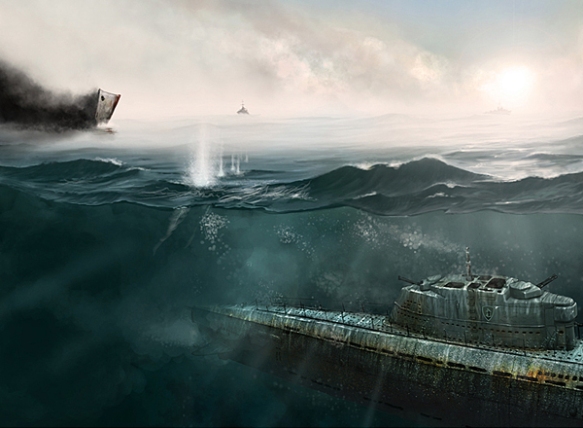U-boot Wilhelm Bauer
The war ended before the Germans could deploy their own next wave of technology embodied by the Type XXI ”Electric” boat, with much larger battery capacity that gave it a fast underwater speed. Until late 1944 Allied bombing had a disruptive rather than disastrous impact on the Type XXI program. The situation changed radically in 1945 when massive raids resulted in the destruction not only of U-boats still on the ways but also of completed U-boats fitting out, or, in some cases, after commissioning and while undergoing training. Thus, quite apart from the damage to construction facilities, 17 completed Type XXIs were sunk in harbour between December 31, 1944 and May 8, 1945: Hamburg – seven; Kiel – six; and Bremen – four.
In essence the Type XXI simply introduced too much that was new simultaneously and demanded too much of those involved in the program. The reasons for this were diverse. In part it was due to the impending defeat on the high seas and the desire to do something – anything – to prevent it. There was also a fascination in Germany for anything that was new and militarily impressive. With hindsight, there also appears to have been an air of unreality about many activities and decisions, some of which may have been due to the pressure of work and others plain ‘woolly thinking’. Unfortunately for the Kriegsmarine, the outcome of all the pressure and cutting of corners was that the boats that were actually completed were constantly having to return to the yards for repair and modification, resulting in delays in attaining full service stratus.
#
At the beginning of the Cold War, all operational submarines used diesel-electric drive. This required submarines either to surface frequently to recharge their batteries, or that they be equipped with a snorkel breathing device. The initial primary focus of submarine development, especially in the United States and the Soviet Union, was the integration of experience from analyzing and operating the German elektroboote into their fleets.
The U.S. Navy took a three-track approach to this task. The first, longer-term approach was to explore new propulsion technologies that would free submarines from the limitations of diesel-electric drive; this led to the introduction of nuclear-powered boats. The second was to develop new designs that embodied the principles of the Type XXI boats within the framework of U.S. requirements. New long-range submarines of the Tang class and short-range hunter-killer types emerged, but their numbers fell far short of the fleet’s requirements. To a great extent, however, budgetary constraints forced the U.S. Navy to pursue most vigorously the least attractive option: modifying, through the GUPPY program, as much as possible of the large existing fleet of new but obsolete submarines built during World War II for greater speed and underwater endurance. Large numbers of almost new Gato, Balao, and Tench class fleet submarines received more streamlined casings and sails, enlarged batteries, snorkels, and improved sensors to suit them for submerged operation for more extended periods.
The Soviet Union followed a somewhat different course in developing its new submarine fleet. In many ways it was far more conservative, from a design standpoint. Essentially, it chose to integrate the principles of the elektroboote into the design of updated iterations of the existing three basic types: coastal, medium-range, and long-range boats. Unlike the United States, the Soviet Union put these new designs into mass production, building 32 coastal Project 615 ( NATO-designated Quebec) boats, more than 200 Project 613 ( NATO-designated Whiskey) medium submarines, and 22 of the long-range Project 611 (NATO-designated Zulu) type.
The Royal Navy took a somewhat different approach to new submarine production immediately after World War II. Alone among Allied navies, it had direct experience in creating submarines with high underwater speed during the war, having converted several S class boats into high-speed targets for antisubmarine forces. It used that experience, plus additional information derived from study of the German elektroboote, to generate its own conversion program to build up a force of fast boats from recently completed T and A class submarines, while working to make more radical propulsion technologies reach production maturity.
The Admiralty looked into nuclear propulsion but decided to exploit the German Walther close-cycle turbine system for its non–air breathing submarines, because it seemed less expensive and closer to being ready for service. Unfortunately, British experts were under the impression that German technicians who had tested this system in a small number of experimental platforms were much closer to solving all of its problems than was really the case. The Royal Navy built two special experimental boats, the Explorer and the Excalibur, as platforms to bring the Walther system to production status; in the meantime, they built new conventional submarines that, while very reliable and generally quite effective, did not represent much of an advance on the conversions of wartime boats or the German elektroboote. The failure of the work in developing a mature Walther system left the Royal Navy no alternative but to turn to the United States for nuclear power technology when the time came for it to build its own submarines that would be free from the limitations of diesel-electric propulsion.
